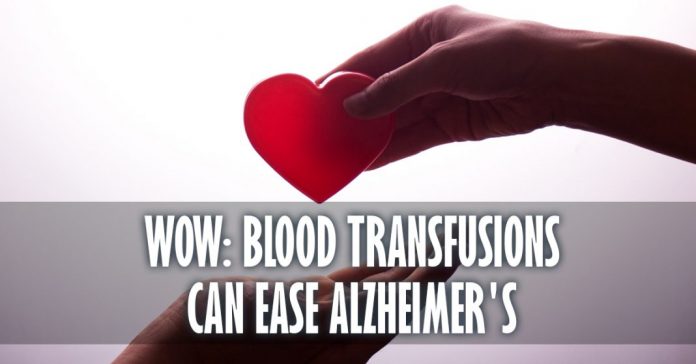Can you catch Alzheimer’s disease? Dread has been developing that the illness may be fit for spreading by means of blood transfusions and surgical gear, yet it has been elusive any proof of this occurrence. Presently a study has discovered that an Alzheimer’s protein can spread between mice that share a blood supply, causing mind degeneration.

Could a little crisp blood turn around the harm of Alzheimer’s illness?
Researchers endeavoring to answer the question say they found the treatments are at any rate safe. Also, they got a little indication that they just may help.
The group at Stanford University found that infusions of plasma from sound young men didn’t hurt the 18 Alzheimer’s patients who got them. What’s more, a couple of the patients seemed to complete somewhat better in the skills of regular living, despite the fact that memory and thinking skills were not influenced.
This does not imply that blood transfusions could treat Alzheimer’s disease, researchers advised. The study is far from showing that. Be that as it may, it does show it merits going ahead with more tests, said Dr. Sharon Sha, who ran the test program at Stanford.
“Although it’s very exciting, it is very early days,” added Sha.
“We need to do the next steps to understand what is in the young plasma.”
Plasma is the liquid piece of blood, with the red cells and immune cells evacuated.
The researchers were working off prior studies from the lab of Tony Wyss-Coray at Stanford, who found that infusing young human plasma into old mice seemed to liven them up. The work stood out as truly newsworthy and propelled an organization, Alkahest, which is attempting to form young human plasma into treatments for maturing related diseases.

Alkahest plans to move forward with formal clinical trials in 40 volunteers next year, said Joe McCracken, vice president for development at the company.
“We do have a study with what we think is a commercially viable product that will start early next year,” McCracken said.
Stanford was doing what’s called a proof of idea trial, just to check the safety of the treatment, in 18 volunteers with direct Alzheimer’s disease.
At first, they did what’s called a blinded trial – treating a large portion of the patients with genuine plasma, and giving a large portion of the patients a sham infusion, with nobody knowing which tolerant got the genuine treatment. At that point, they swapped the two sides.
Afterward, because it was taking so much time and exertion, they slice the trial to just nine individuals and each of the nine knew they were getting the genuine article – a unit of plasma, once every week for a month, from solid young men younger than 30.
There was no measurable impact on memory or considering, the group told the Clinical Trials on Alzheimer’s disease meeting in Boston. In any case, Sha said on two measurements of capacity there was a distinction in answers the caregivers gave on a questionnaire.
“Narratively, when I saw these patients and parental figures, those that did say they had an improvement…they might have said things like ‘they are more engaged’, ‘they are participating on conversations more’,” she said.
But that doesn’t mean there really was an effect. You just cannot tell with a trial of only 18 people.
“I stress that individuals would take this clue and say, ‘I need to get this. I need to get young blood.’ It’s important to understand the science behind this first,” Sha said.

More than 5 million Americans have Alzheimer’s, and this number is required to develop as the populace ages. There’s no cure, and treatments that have looked promising have floundered in huge trials.
“There are things you can do but right now there is no drug that is actually going to slow down the progression of the brain disease in Alzheimer’s,” said Keith Fargo, director of scientific programs for the Alzheimer’s Association.
But Fargo called the findings intriguing.
“They showed it was safe and tolerable treatment at least for this small number of people,” Fargo said.
Sha says it’s not clear what might be found in plasma from young people that might help the symptoms of Alzheimer’s. “There is a theory that there is an inflammatory process that is driving the disease and the plasma is helping that,” she said.
Any genuine treatment would not include entire plasma, McCracken said.
He said the company has developed a safer plasma product that has blood clotting factors removed, as well as immunoglobulin. Whole plasma must be matched to blood type.
And, McCracken says, the company is working to figure out just what it is in the plasma that might affect aging and disease.
Source: https://www.nbcnews.com/health/health-news/young-blood-safe-just-might-help-alzheimer-s-patients-n817451









